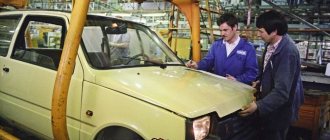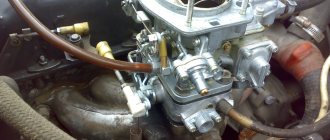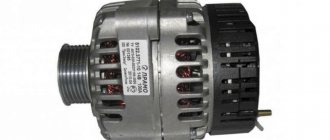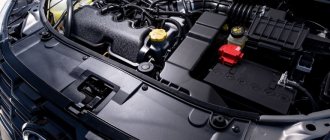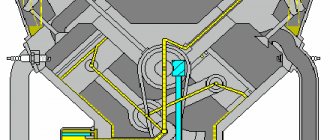Technical characteristics of the Oka engine
The clutch is single-disk, with a diaphragm spring, the clutch release drive is cable, with a backlash-free installation of the clutch release bearing. Gearbox – 4-speed, with synchronizers in forward gears. Send numbers: I – 3.7, II – 2.06, III – 1.27, IV – 0.90, 3X – 3.67. Main gear – cylindrical, helical, gear. number – 4.54. The wheels are driven by shafts with constant velocity joints.
Fuel tank - 30 l, AI-93 gasoline. Cooling system – 4.8 l. antifreeze A-40;
Engine lubrication system – 2.5 l. Oils used: M-6/10G, at temperatures from plus 20 to minus 25 degrees C; M-6/12G, at temperatures from plus 45 to minus 20 degrees C; M-5/10G, at temperatures from plus 30 to minus 30 degrees C;
Gearbox housing - 1.8 l, see engine oils;
Hydraulic brake system - 0.55 l, Neva, Tom, Rosa fluids; Hydraulic struts for front suspension 2×0.27 l, MGP-10; Rear shock absorbers 2×0.143 l. MGP-10; Windshield washer reservoir – 2.0 l, NIISS-4 liquid and mixtures with water.
The fate of "Oka". Other names
VAZ introduced a new competitor to the Mercedes ml. It is not clear why the news about the appearance of a new AvtoVAZ model drew attention only in the first quarter of 2022, the Lada Vesta Cross car model was presented for the first time at Moskovskaya. I always liked the dynamic window sill line, which goes without breaking into the hood connector on the first Oka; this primarily distinguished it from the prototype of the Daihatsu Cuore.
| Engine | Box | Drive unit | Consumption, l | Acceleration to 100, s. |
| 0.6 29 hp petrol | Mechanics | front | 6.5/5.5 | 30 |
| 0.7 33 hp petrol | Mechanics | front | 6.4/5.4 | 24 |
| 0.7 35 HP petrol | Mechanics | front | 6.4/5.4 | 24 |
| 1.0 53 hp petrol | Mechanics | front | 7.4/5.0 | 18 |
| 1.1 49 bhp petrol | Mechanics | front | 7.4/5.1 | 18 |
Modifications and updates Edit
Over the many years of production, the Oka was regularly modernized: the instrument panel, the heating and ventilation system of the body, as well as some body parts, primarily the plastic body kit, including the radiator grille and bumpers, were repeatedly changed. Larger wheels began to be used (R13 instead of R12).
In 2006, production of Oka at ZMA was discontinued due to the purchase of this enterprise (now Sollers).
SeAZ-11116 - one of several modifications of the Oka
At the only remaining SeAZ in 2006, production of its modification SeAZ-11116 with a Chinese 3-cylinder 1.0-liter injection engine (Oka-2) was launched. In addition to the new liter three-cylinder engine (instead of the previous 0.8 liter two-cylinder), the car received a new five-speed manual transmission, the maximum speed increased (from 123 to 150 km/h), and the acceleration time to 100 km. per hour (from 27.5 to 18 sec). The new engine made it possible to ensure compliance with Euro-2 environmental standards, and since January 2008 - Euro-3.
In 2007, a pilot production batch of pickups and vans of the SeAZ-11116-50 subfamily was produced, and a reinforced version of the SeAZ-11116-60 pickup, semi-frame design, with a load capacity of 400 kg, was developed. Despite the fact that these were the most affordable commercial vehicles, they did not go into production.
In January 2009, SeAZ stopped production of Oka due to its unprofitability.
Oil change Maintenance
| Oka engine: characteristics, weight, design and repair If the pump fails, the engine overheats and breaks down, so you need to monitor the temperature of the unit and change the pump in a timely manner, if necessary. Consistently turning the crankshaft half a turn, which corresponds to turning the mark on the camshaft pulley by 90, adjust the clearances of the remaining valves according to the order indicated in the table. |
- power - 30 forces;
- volume – 649 cubic meters. cm.;
- torque - maximum 44 Nm at 3400 rpm;
- recommended fuel is gasoline with an octane rating of 92;
- cylinders: 2;
- type of food – carburetor;
- valves – 4;
- fuel consumption – about 4.7 liters per 100 km;
- engine cooling – liquid;
- engine environmental standard: Euro-0.
Valve timing • Thus, the exhaust cycle is 252.
Cylinder block
The power plant crankcase is made of cast iron. As on all VAZ models, the cylinders are not inserted, but bored into the block. The cooling system channels (the so-called “jacket”) run throughout the block.
Since the power unit is a two-cylinder, in-line, there are only three supports for the crankshaft main journals at the bottom of the block. During the production process, high-precision machining of the working surfaces of these supports is carried out simultaneously with the covers.
As a result, each support has its own cover and they cannot be swapped, otherwise the crankshaft may rupture during operation of the car. To eliminate the possibility of installing the cover in the wrong place when repairing the power unit, they are marked.
The cylinder head is solid cast aluminum. Since the engine has a timing belt with an overhead camshaft, the cylinder head is equipped with beds for the shaft. To install the camshaft, three beds with covers were made. There are no shaft bearings; their role is played by the working surfaces of the bed and cover (therefore, if the bearings are heavily worn, the entire head must be replaced).
The cylinder head also houses timing valves (2 for each cylinder). As usual, the intake valve, to ensure better filling of the cylinder with the combustible mixture, has a larger diameter than the exhaust valve.
The cylinder head is fixed to the block with 6 bolts. When tightening fasteners, a certain pattern is used, which eliminates the possibility of the head being “skewed.”
Bolts require gradual tightening with increasing tightening torque. The force on the cylinder head mounting bolts has strictly defined values, so tightening must be done with a torque wrench.
The camshaft is made of cast iron, has a high degree of processing of the working surfaces - bearing journals and cams. In addition to acting on the valves, the camshaft also drives the vacuum fuel pump, for which there is an eccentric on the rear of it.
Thermal clearances on Oka engines are adjusted using special washers installed between the camshaft cams and valves.
The crankshaft is a magnesium cast iron casting with subsequent high-precision machining of the working surfaces. It has 3 main journals and 2 connecting rods. 4 shaft cheeks, located between the journals, act as counterweights that reduce motor vibration during operation. The working surfaces of the crankshaft are lubricated through oil channels made inside the shaft.
History of VAZ 1111/11113 engines
The engineers who developed the Oka car faced a rather difficult task - to make a compact and affordable vehicle, made from common components and with good maintainability. Similar requirements were put forward for the engine - it had to be simple, reliable and easy to repair in the event of a breakdown outside specialized service stations with qualified personnel.
Description
The presented model is a type of four-stroke carburetor-based engine.
Its distinctive feature is that the camshaft is located at the top of the Oka engine. Not all modern and old power units are equipped with such a feature.
It is worth noting that all cylinders are in-line, which allows for very good technical potential. The designers of the Oka car took one half of the well-known VAZ 21083 and made it the basis. It follows from this that some parts and mechanisms are no different from their older brother.
As for the cooling system, there is a closed-type liquid circulation. Therefore, the Oka engine will be able to operate in any weather conditions, which is very good. He is not afraid of severe frosts and heat. Thanks to the combined lubrication system, all parts and mechanisms will work virtually without failure.
Performance characteristics of the VAZ 1111 Oka © Engine characteristics
Vibration has a constructive reason and is caused by the operation of only 2 pistons, which have a working stroke of only 2 rotations of the CV, that is, during operation, 1 piston rotates the CV 360°. Strict price restrictions implied constant control of the cost of the product at all stages of its development; the 3500 bar itself was at the level of the then prices for classics.
| Class | Engine cylinder diameter 1111, mm | Engine cylinder diameter 11113, mm |
| A | 76,000. 76,010 | 82,000. 82,010 |
| IN | 76,010. 76,020 | 82,010. 82.020 |
| WITH | 76,020. 76,030 | 82,020. 82,030 |
| D | 76,030. 76,040 | 82,030. 82,040 |
| E | 76,040. 76,050 | 82,040. 82,050 |
Design
In fact, this is a standard engine from the VAZ 21083, which is very popular. The Oka engine is slightly modified and weighs half as much. Due to this, it was possible to obtain low fuel consumption and high efficiency.
It is based on a simple four-stroke power unit running on gasoline fuel. The main features include the overhead camshaft and in-line arrangement of the cylinders. Thanks to this, it was possible to obtain high power.
A little history. Other names
| How much does an Oka body weigh empty 900 Oil pressure in the engine lubrication system at an oil temperature of 85C and a crankshaft speed of 5600 rpm, not less, MPa kgf cm 2 0.45 4.5 Minimum oil pressure in the engine lubrication system at an oil temperature of 85C and crankshaft rotation speed 820. In addition, at the SeAZ plant, before the production of the Oka ceased, a model was produced with the 11116 engine, a licensed three-cylinder injection engine of Chinese origin TJ 376 QE. |
- factory production flaws, when the gasket was manufactured with inaccuracies;
- Incorrect tightening of the cylinder head, in which the gasket is not fully compressed.
Defects of engine parts • VAZ 11113 Oka technical characteristics, review, reviews.
All modifications Edit
- VAZ 1111
is a basic model with a 2-cylinder VAZ-1111 carburetor engine with a volume of 0.65 liters. Produced from 1988 to 1996. at VAZ and SeAZ (“Oka”), KamAZ (“Kama”) - VAZ 1111E
– look here - SeAZ 1111-01
- a social model based on Oka for people who do not have two legs - SeAZ 1111-02
- a social model based on Oka for people who do not have one leg - SeAZ 1111-03
- a social model based on Oka for people who lack one arm and leg
VAZ 11113 - modification with a 2-cylinder carburetor VAZ-11113 engine with a volume of 0.75 liters. Produced from 1996 to 2007. In 2000, at Autoexotica-2000, a version with a 2-door sedan body with a separate protruding trunk with a volume of 200 liters was demonstrated
- SeAZ 11113-01;02;03
– a similar version of the previous ones - SeAZ 11116
is the final modification with a Chinese engine from FAW with a volume of 1 liter. It is already being produced at SeAZ. - SeAZ 11116-01;02
is a similar version of the previous ones. Due to safety reasons, it was forbidden to release version 03, since it requires two hands to steer. - SeAZ "Oka Junior"
is a sports version for novice racers. The only difference is that almost everything has been removed there. - SeAZ "Oka Sport"
is also a sports version of Oka. There are Sparco seats and a roll cage. - "Oka-Astro-113011"
- a tuning version of the "Oka" produced in 2006-2007. in Naberezhnye Chelny, for individual orders, a small one based on Serpukhov bodies and equipped with a Ukrainian MeMZ-2451 injection engine with a volume of 1.1 liters of Euro-2 level. It differed only in the widened track of the front wheels - VAZ 17013 “Toima”
– erase here - VAZ-1301 “Gnome”
is a prototype of a pickup truck based on the Kama Oka. The chassis design is semi-frame. Load capacity - up to 350 kg (without passenger). Not mass produced - SeAZ-11116-010-50 “Oka Van”
and
SeAZ-11116-011-50 “Oka Pickup”
– see here - SeAZ-11116-010-52 "Oka Universal"
- a commercial modification of the "Oka" with a van-type body (a hatchback body with unglazed sides and a cargo compartment instead of the rear part of the passenger compartment). Several prototypes were produced in 2007. - SeAZ-11116-60 “Oka Pickup with increased payload” –
see here - T
– watch here - Oka NEV ZEV
– view here
"Oka-Astro-11301" - a small-scale version of the "Oka" produced in 2002-2006. Chelny Small (later Kama Automobile Assembly Plant) and equipped with a Ukrainian MEMZ 245.1 carburetor engine derated to AI-80 with a volume of 1.1 liters of Euro-0 level and a power of 49 hp. With. It was distinguished by an extended wheelbase (version 11301) and a widened front wheel track. The spare tire was moved to the trunk. This design turned out to be too “crude” due to the use of a number of “handicraft” parts
"Oka" VAZ (SeAZ, KamAZ)-1111
- Soviet and Russian minicar passenger car of the first group of the especially small class (segment A - minicars). The car was developed at the Volzhsky Automobile Plant and produced at VAZ, KAMAZ and SeAZ in 1988-2008.
Motor VAZ 11113
Since 1995, a new 0.75 liter engine has been installed on the Oka.
It is believed that this modification is highly economical. Thanks to the low operating speed, the minicar engine “eats” only 6 liters of gasoline when driving 100 km in the city. The maximum speed of the VAZ-11113 Oka is 130 km/h. The power unit is a two-cylinder engine. Many parts are interchangeable with the VAZ 2108 engine, but this does not mean that the power units are identical. To remove the strong vibration inherent in a two-cylinder engine, there is a special balancing shaft on which counterweights are installed to dampen vibrations. The shaft has a rigid drive in the form of gears. This is the cause of the rumbling noise of an engine that is not warmed up to operating temperature.
As it warms up, the noise disappears, but not completely. This is a serious irritant for drivers who have just started operating an Oka car. The technical characteristics of this mechanism play an important role in the operation of the entire unit. And after a short period of time, addiction develops, and other advantages of a small machine begin to dominate this disadvantage.
The car's ignition system is one of the most reliable in the world. The weak point in a contactless electronic system can only be the ignition coil. Otherwise, the system is very reliable; it is enough to monitor the condition of the high-voltage wires and promptly replace the spark plugs.
Another feature of the engine: for reliable and long engine service, it is necessary to maintain a strictly average oil level. Overfilling or lack of lubricant will very quickly lead you to a repair shop. And the cost of repair work will be the same, regardless of the model, be it a Lada Kalina or a VAZ 1111 Oka.
Vehicle identification
Like all cars, the Oka had identification numbers applied to the body and engine. The body number was additionally an identification designation of the car itself.
The identification number was applied to the car body in three places, which eliminated the possibility of counterfeiting. The first number was applied to a special plate attached to the front of the body, in the engine compartment. This plate also carried information in the form of a code about the manufacturer; the model index and model year of manufacture were applied to it.
The identification number was additionally applied to the body under the air intake grille located near the windshield.
The third number was applied inside the cabin, on the cross member of the trunk floor.
The engine had an identification number in only one place - on the front cylinder block, next to the second cylinder.
Related link:
Generator OKA
Engine cutaway view
The VAZ car surprises with its technical characteristics despite its more than modest size. The Oka accelerates quite quickly, has excellent cross-country ability, and at the same time is very economical in fuel consumption. But the new product did not go into wide production due to many problems and the need for improvements, although today you can still buy a kit to convert the engine into an injection one.
Tuning
Many drivers want to make a real monster out of their iron horse. This also applies to the small car Oka.
If you want to increase power, you can tune the Oka engine.
This requires a special tool, workshop and experience:
- The first step is to replace the cylinder head, air filter, buy a new camshaft and carburetor. In fact, this is the bare minimum that can be done at the first stage.
- You know that Oka's car does not have a very large engine capacity, and there is no way to fix this. Of course, you can try to install a different engine, but this is very difficult and time-consuming. Less expensive is chip tuning, which allows you to slightly increase torque and compression. In addition, fuel consumption is reduced, which is very good.
- Many experts recommend grinding the manifold, lifter and camshaft. These actions relate to the main tuning of the Oka engine. With this you can not only increase power, but also make the engine run smoothly.
- Many drivers ask the question: what engines can be installed on an Oka car? And the answer is very simple. Only standard or slightly modified from VAZ 21083.
"Oka" -11116. Other parameters of vaz 1111 oka
At one time, the Serpukhov Automobile Plant produced the S-3D motorized wheelchair, which was mainly intended for people with disabilities, and was popularly called a wheelchair. Similar requirements were put forward for the engine: it had to be simple, reliable and easy to repair in the event of a breakdown outside specialized service stations with qualified personnel.
| length, mm | 3200 |
| width, mm | 1420 |
| height, mm | 1400 |
| ground clearance, mm | 150 |
| wheelbase, mm | 2180 |
| front track, mm | 1210 |
| rear track, mm | 1200 |
| turning radius, m | 4,6 |
How to disassemble a VAZ Oka engine. Maintenance
| Directory: VAZ-1111; OKA; (catalog 2000) (1111) - description, characteristics, history. piston class by pin hole 1, 2, 3 2 piston class by diameter A, B, C, D, E 3 arrow showing the direction of piston installation 4 weight group normal G, increased by 5 g, decreased by 5 g - 5 the repair size diameter is increased by 0.4 mm D, by 0.8 E. At this mileage, it is strictly necessary to replace a worn timing belt if it breaks, the valves bend, which will lead to the need to change the engine or make expensive repairs. |
| Engine OKA 11113: Technical characteristics. As a custom project, the owners of these cars can install an injector from a VAZ-21083i engine with improved characteristics, but this is a rather labor-intensive and financially expensive operation. However, the Russian brand had its own characteristic differences; at least the domestic car had a power unit and transmission of its own design. |
- at the Volzhsky Automobile Plant in Tolyatti;
- in Serpukhov (SeAZ);
- in Naberezhnye Chelny (ZMA).
general description
The VAZ-1111 engine is an in-line, two-cylinder, transversely mounted. Thanks to this arrangement, the engine compartment turned out to be compact, which made it possible to reduce the overall dimensions of the car. The engine received a liquid cooling system with forced circulation, a carburetor power supply system and an electronic ignition system.
Model 11113 has the same design of the power unit. The difference between the engines of these modifications is the basis. Version 1111 is, in fact, “half” of the 1.3-liter VAZ-2108 unit, and 11113 is a 1.5-liter engine of the same G8. Because of this, the engines have different engine displacement and power.
The power plant is fixed in the engine compartment on a special subframe. The manufacturer did not provide protection for the Oka engine.
Despite the fact that the installation was based on a 4-cylinder engine, the Oka unit has one very interesting feature - synchronous stroke of the pistons. If you look at the Oka engine in cross-section, the pistons are located at the same level and “walk” together, but the cylinders function separately.
The operating principle of an engine with this design feature is quite simple - the strokes in the cylinders are offset. That is, if the compression stroke occurs in the 1st cylinder, then the exhaust stroke occurs in the 2nd cylinder. And so on for all strokes, so the cylinders in this engine work alternately.

